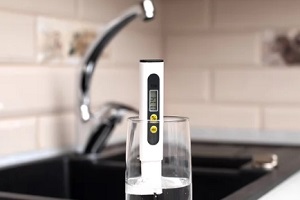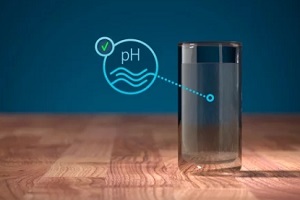 The measurement of pH is used to determine how acidic or alkaline water is, and depending on the numbers, those levels can impact your health and your home’s plumbing. Keeping your water’s pH balanced protects your pipes and fixtures while ensuring safe, good-tasting drinking water.
The measurement of pH is used to determine how acidic or alkaline water is, and depending on the numbers, those levels can impact your health and your home’s plumbing. Keeping your water’s pH balanced protects your pipes and fixtures while ensuring safe, good-tasting drinking water.
This article will look at what pH represents, how it influences water quality, ideal pH ranges, and how to balance pH in water in your home.
What Is pH?
pH is the abbreviation for “potential hydrogen” and represents your water’s hydrogen ion concentration. The pH scale starts at 0 and goes up to 14, with a pH of 7 being neutral, while readings below 7 are considered acidic, and those above 7 are alkaline.
Each pH number represents a tenfold difference in acidity or alkalinity. For example, pH 3 water is ten times as acidic as pH 4 and 100 times as acidic as pH 5. You can test your water’s pH at home with chemical test strips that change color and are available at pool supply stores, among other sources. For the most accurate readings, use an electronic pH meter.
How Does pH Affect Drinking Water Quality?
The pH level can affect how your water tastes, smells, and looks and can also impact safety. Extremely high or low pH levels outside the ideal range can also damage pipes, faucets, and appliances.
Acidic Water
Water with a pH lower than 6.5 can cause corrosion in pipes, valves, and other metal plumbing components. This corrosion causes blue-green stains on sinks and tubs as copper wears away and re-deposits. Lead, copper, and other dangerous metals can also seep into your water from corroded plumbing. Acidic water might taste sour, bitter, or metallic.
Alkaline Water
On the other end of the spectrum, alkaline water over pH 8.5 dissolves and transports minerals that leave scale deposits or lime buildup on plumbing fixtures, showerheads, and appliances. Scale buildup clogs pipes, reducing water pressure and flow, and, over time, it can result in significant plumbing damage. Alkaline water feels slippery, tastes bitter, and has an unpleasant odor.
What’s the Best pH Range for Drinking Water?
While the EPA doesn’t regulate pH, they recommend a pH between 6.5 and 8.5 for optimal drinking water safety and quality. Most water supplies in the U.S. naturally fall within this ideal range. Water featuring a pH between 6.5 and 8.5 tastes good and reduces the risk of corrosion or scale.
The pH of your local water depends on the surrounding environment and geology. Areas with limestone bedrock, for instance, often have higher pH water, while mountain regions prone to acid rain may have lower pH source water.
How Can Unbalanced pH Water Affect Your Health?
While pH itself doesn’t directly cause health issues, very high or low values allow harmful contamination that could cause problems if ingested long-term.
 Acidic water may corrode pipes and plumbing, releasing copper, lead, zinc, and other metals into the water. Too much exposure to these metals, especially in children, is linked to developmental and neurological problems. Adults may experience nausea, vomiting, and other stomach troubles from ingesting high metal levels over time.
Acidic water may corrode pipes and plumbing, releasing copper, lead, zinc, and other metals into the water. Too much exposure to these metals, especially in children, is linked to developmental and neurological problems. Adults may experience nausea, vomiting, and other stomach troubles from ingesting high metal levels over time.
On the alkaline side, dissolved mineral deposits themselves aren’t toxic, but heavy-scale buildup promotes bacterial growth and can shield radioactive particles that leach from certain minerals. At high concentrations, long-term radium and similar contaminant ingestion may increase cancer risk.
How to Balance the pH in Water in Your Home
If testing shows your water’s pH is outside the ideal 6.5 to 8.5 range, several effective treatment options can restore proper pH balance:
- Test the water to identify your actual pH with simple test strips or an electronic meter.
- Treat acidic water with a calcite or magnesium oxide filter to raise pH safely.
- Alkaline/hard water above pH 8.5 needs a water softener. Ion exchange resins swap out scale-causing minerals for non-scaling sodium ions.
- Reverse osmosis is sometimes used in conjunction with softeners or neutralizers when pH adjustment alone doesn’t completely solve water quality issues.
It is wise to consult a local water treatment professional to provide expert recommendations tailored to your unique water chemistry and home setup. Properly installed and maintained systems can automatically maintain an optimal 6.5-8.5 pH balance.
Why Regularly Monitor and Control pH?
Water composition varies seasonally; test pH a few times a year or if you notice changes in your water’s taste, smell, and appearance or if your plumbing and appliances are having issues. Regular screening ensures your tap water’s pH stays in the healthy range and prevents problems.
 If your water’s pH is not balanced, take action to neutralize it and avoid hazardous metal contamination from corrosion or scale buildup choking plumbing. Balanced water also allows appliances to run at peak efficiency. Protecting your home, budget, and health makes frequent monitoring and pH control an intelligent time investment.
If your water’s pH is not balanced, take action to neutralize it and avoid hazardous metal contamination from corrosion or scale buildup choking plumbing. Balanced water also allows appliances to run at peak efficiency. Protecting your home, budget, and health makes frequent monitoring and pH control an intelligent time investment.
Consider installing an automatic pH controller on your water softener or neutralizer if your supply’s chemistry fluctuates. These devices automatically adjust treatment levels in response to varying pH for hassle-free maintenance.
Balance Your Water’s pH Effectively with Assistance from Hawaiian Cool Water
Safe, good-tasting water starts with a balanced pH. Understanding your source water’s natural pH tendencies based on the environment allows you to select the right treatment to deliver neutral water to your home. Additionally, monitoring and controlling pH prevents contamination, scale, and corrosion concerns from unbalanced water.
Hawaiian Cool Water specializes in water testing and pH correction solutions. Our experienced team is ready to partner with you to ensure your drinking water’s pH is right where it needs to be for your health and home. Contact us today at (808) 755-2369 or online to discover how we can help test your water’s pH and recommend the best treatment to bring levels into balance.


